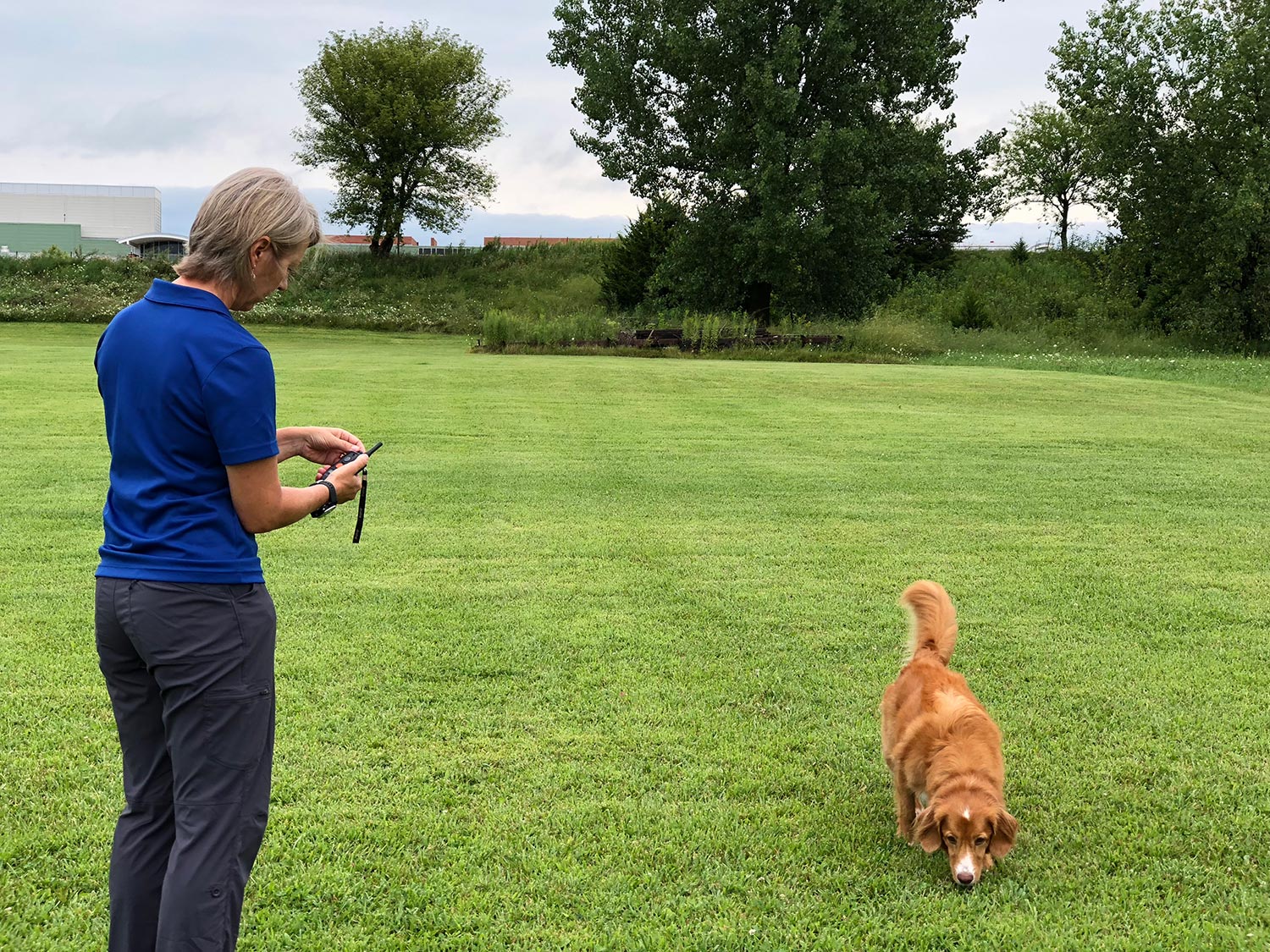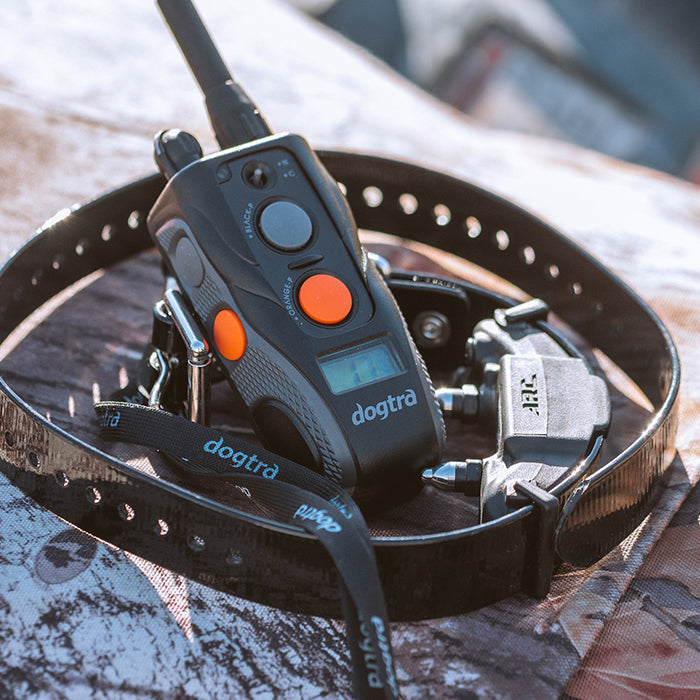DOGTRA COLLAR TROUBLESHOOTING: 4 TIPS

Dogtra Collar Troubleshooting
As a professional dog trainer, one of my responsibilities is to troubleshoot training problems. As a trainer that utilizes electronic training collars, I also have to troubleshoot potential equipment problems. Questions regarding the equipment are routine, particularly when the user is new to remote collars. Keep reading to learn essential Dogtra collar troubleshooting tips for optimal performance.
Common Issues with E-Collars
Often people suspect the equipment to be malfunctioning. Some of the most common statements are: “I started using the e-collar and over the past few weeks it seems that it is no longer working.” “My dog isn’t responding to the stimulation, only the vibration. So I don’t think my collar is working properly.” “Sometimes my dog seems to respond and other times, nothing. I think my collar is broken.”
I want to acknowledge that it is certainly possible to have a malfunctioning e-collar. Any piece of mechanical equipment can experience problems, whether it is our car, a cell phone, or our dog training equipment. However, malfunctions are fewer and farther between than most people might believe. More often than not, there is a level of human error or misunderstanding when these situations arise.
Dogtra Collar Troubleshooting Tips
When it comes to e-collar troubleshooting, I don’t want you to just take my word for it, so I’ve asked two colleagues to weigh in on the topic. Pete Fischer and Pat Nolan (patnolan.com) are highly accomplished trainers and fellow Dogtra Pro Staff members that have a wealth of wisdom and knowledge to share. I chatted with them, and we came up with a checklist that you can run through to help you determine if your collar is functioning properly or not. Let's start with the basics.
1. Check Your Equipment
Make sure your battery is charged in both the collar and the transmitter. Low battery charge can make for inconsistent functioning. Make sure both pieces are turned on and that the unit is properly synced so that the collar is receiving a signal from the transmitter. The easiest way to test if the unit is synced is to activate the pager function (vibration) while holding the collar in your hand. If you feel the vibration sensation, you know that the unit is charged, turned on, and synced properly.
Next, test to make sure the stimulation is working. It is easiest to do this by placing the collar on your wrist, starting out with the lowest level, and gradually adjusting the stimulation up to a level that you can feel. Stimulation travels from one contact point to the other across the skin surface, so make certain BOTH contact points are touching your skin equally.
IMPORTANT NOTE: Sensitivity to stimulation is different for everyone. Some people (and some dogs) are very sensitive and can detect sensations at very low levels. However, Pat, Pete, and I agree that most people will not feel the Dogtra stimulation level until somewhere between 15 and 30.
And some people are less sensitive, so they don’t feel the stimulation until even higher levels. The important thing is: don’t conclude that the collar isn’t working just because you can’t feel it on a level that you “think” you should. Be sure to turn the dial up far enough to be certain there either is or isn’t any stimulation occurring. Once you find a level that you can feel, tap the button multiple times to make sure it is activating consistently.
Pat Nolan brought up an important point during our conversation. He recommended checking the range of the e-collar when experiencing inconsistencies. If the transmitter has been dropped on a hard surface or otherwise damaged, it’s possible the antenna is broken. If the internal antenna wiring is damaged, the collar range will be limited, and there will only be a signal response when the transmitter and collar are within a few yards of one other. In order to test this, have someone activate the remote as you walk a distance away from your helper with the collar in your hand.
Pete added that range could also be compromised by contact with your body. When you are working with your dog at a distance, avoid interference by holding the remote away from your body and keeping your hand and fingers off of the antenna.
Once you’ve concluded that the equipment is functioning properly, you may move on to troubleshooting the proper fit on your dog.
2. Ensure Proper Fit
To ensure a correct e-collar fit, the collar should be placed fairly high on the neck toward the ears rather than closer to the shoulders. The contact points must touch your dog’s skin, which means that the e-collar should fit snugly. If the collar spins freely as the dog shakes or moves, it is too loose. The contact points can easily lose connection with the skin surface, and the dog will not feel the stimulation, regardless of the intensity setting.
Hairs built up under the contact points can act as an insulator and create an inconsistent response. Brush and groom your dog routinely to minimize potential problems, and be sure to work the contact points through the fur to the skin surface before buckling the strap down. If your dog has an extremely long or thick hair coat, you may want to thin the coat slightly to allow for better contact. You do not need to shave to bare skin; only lessen the amount of hair in the area of the contact points.
Now that you’re certain the e-collar is functioning, AND you’ve fitted it correctly, let's examine other possible reasons for inconsistent responses from your dog.
3. Adjust Stimulation Levels
E-collars are designed with variable stimulation for a reason. There isn’t a perfect level that works for every dog, plus the level the dog notices and responds to can change depending on the distractions in the area and how much training the dog has had.
It is very normal for inexperienced dogs to be responding well to the e-collar and then suddenly get distracted and act as if they aren’t feeling the static sensation at all. It is also very normal for some dogs that are new to an e-collar to not notice the static until you go up the dial considerably. Once they become aware of the sensation, you can turn the stimulation back down while still maintaining their attention to it.
More often than not, a beginning dog’s inconsistent response to static isn’t a problem with the equipment. It is normal part of the dog to be new to the sensation or be distracted by his/her surroundings. It requires the e-collar operator to adjust the level, and it is why Dogtra e-collars offer a wide variety of stimulation levels.
I’ve personally worked dogs that are in the ’80s and ’90s, and they barely blink an eye and other dogs that work beautifully and pay attention at levels in the single digits. The user’s goal is to adjust the dial as needed.
Be aware that if there is a sudden distraction that causes an adrenaline surge, the dog’s sensitivity to tactile sensation can diminish. If you’ve ever discovered a bruise on your body but had no recollection of how it occurred, you’ve experienced this. Our sensitivity changes depending on how excited or distracted we are. Athletes give one another some intense body slams and high fives in the heat of a game, but if they used that same intensity during a lunch meeting, it would be out of place. By the same token, the equivalent pressure of a lunch meeting handshake would go unnoticed when we’re 3rd down with 5 yards to go to win the big game.
Pete summed up the need for varying the intensity this way;
“You will probably be changing the stimulation level multiple times as your session progresses. The way a dog reacts will vary depending on his/her tolerance to the static, the distractions in the environment, and your ability to identify that the dog is actually feeling the stimulation. Think of using stimulation levels the way you use your voice to speak with someone. You use one level in the library, another level in a restaurant, and still another level in the subway when there is a train going by. The goal is for your friend to be able to hear you in each situation.
It is crucial to know what to watch for as you try to determine if your dog is feeling the e-collar. A jump or startle response isn’t the ideal response. In most training situations, I’d say that even means you’ve gone a bit higher than needed. Once you’re certain the dog is feeling it, keep training. Repetition is one of the main keys to success. Check out this article for signs to look for when deciding if your dog is feeling the e-collar or not.
4. Check the E-Collar Range
When troubleshooting a Dogtra collar, one important factor to consider is the range of the e-collar. The e-collar is designed to work within a specific range, and if you are experiencing issues with the collar, it's essential to check whether the collar is within range or not. A low battery or other environmental factors such as interference or obstacles may also impact the range of the e-collar. Therefore, it's crucial to ensure that the e-collar is fully charged and that you are training your dog in an area with minimal interference. By ensuring that the e-collar is within range, you can guarantee that your dog is receiving consistent and effective training, making the process more efficient and more comfortable for both you and your furry friend.
Conclusion
The e-collar is a great tool. It can help the dog learn and speed up the process, but it doesn’t replace the need for practice and consistency. And please remember to keep a leash or long line on the dog for the first few training sessions. Helping your dog respond properly by using the leash and e-collar together will make the training easier for both of you.
Happy Training!




